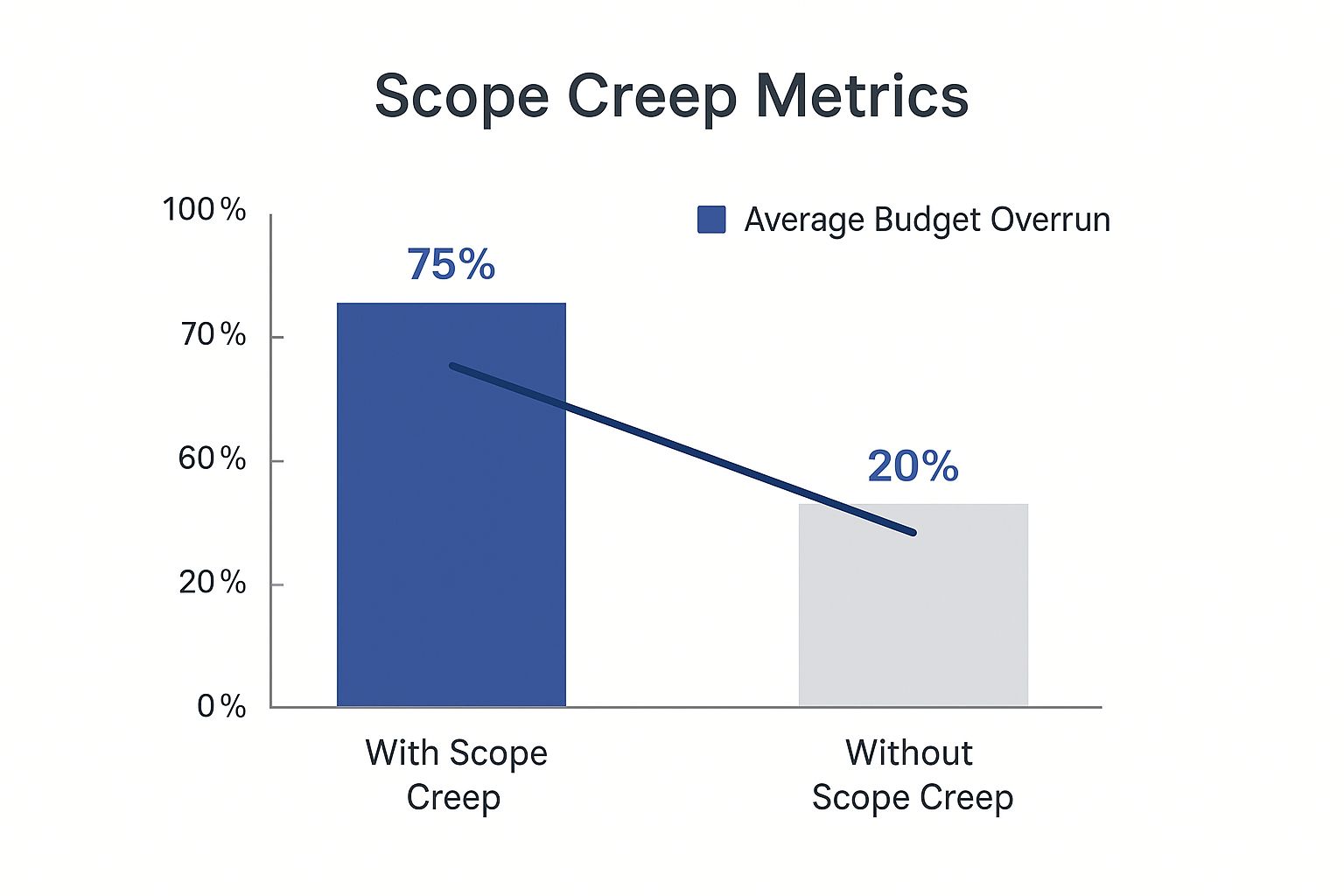Why Client Expectations Make or Break Your Projects

Let’s be real for a second. Most project disasters don't come from a sudden technical issue or a last-minute deadline change. They happen slowly, derailing over time because of a basic disconnect—a gap between what the client imagines and the reality of your process. This gap, full of unstated assumptions about timelines, costs, and deliverables, is where trust disappears and frustration takes over. Managing client expectations isn't just a soft skill; it's the foundation of any successful project and a healthy working relationship.
Think of it like building a house. If your client is picturing a two-story home but the blueprints you’re working from show a bungalow, no amount of quality work will stop the final reveal from being a total letdown. The important work starts way before you write a single line of code or create the first mockup. It begins by creating a shared vision.
The True Cost of Misalignment
When expectations and reality don't match up, the problems spread through every part of the project. A small misunderstanding about what’s included can quickly turn into scope creep, where endless "small" additions slowly bloat the project, eat up your resources, and push deadlines further and further away. This is more than just annoying; it directly hurts your profitability and your team's morale.
One study revealed that 41.1% of digital marketing professionals find managing client expectations to be a major struggle, so it's a common challenge. The trouble often starts in the very first conversations. We get so focused on winning the project that we might unintentionally set ourselves up to fail by not clarifying the tough details right away. But spending that time on clear communication upfront is what separates the seasoned pros from those who are always putting out fires.
Setting the Tone from Day One
That first client meeting is much more than a simple introduction. It's your best chance to build a partnership grounded in transparency. This is where you shift from being just a service provider to becoming a trusted guide. Instead of just nodding along to their goals, you can start working together to define what success actually looks like and map out how you'll get there.
This proactive stance even impacts your ability to win new clients. Research indicates that a whopping 79% of customers make their initial buying decision based on how well a company seems to understand their needs. By showing you have a clear process for managing expectations from the get-go, you're not just planning a project; you're building the client's confidence in your ability to deliver. You can explore more about how understanding customers shapes decisions on InMoment.com. Ultimately, investing this time upfront does more than prevent future headaches—it builds the foundation for long-term trust and repeat business.
Reading Between the Lines: What Clients Actually Need

Beyond the project brief, every client brings a set of unspoken needs and past experiences that shape their expectations. A client who was burned by scope creep on a previous project isn't just buying a website from you; they're looking for reassurance that you have a solid process. Another who felt ignored by their last agency wants to know you value clear, consistent communication. The most effective way of managing client expectations is to uncover these hidden drivers before they become problems.
This is where active listening moves beyond a simple buzzword. It’s about asking probing, open-ended questions that peel back the layers of the initial request. Instead of just accepting "I need a new landing page," try asking, "What happened with the last landing page that didn't work for you?" or "What's the one thing that would make this project feel like a huge success to your team?" Their answers often reveal more about their anxieties and true goals than any formal document ever could.
The ability to do this well is a core part of the customer experience, a market that has grown into a $7.6 billion industry by focusing on these deeper client connections. To get a better sense of this growing field, you can dive into customer experience statistics on HelpScout.com. Understanding these nuances isn't just good service; it's smart business that builds trust and prevents future headaches.
From What They Say to What They Mean
Distinguishing what clients think they want from what they actually need is a skill that separates good service providers from great partners. Often, a request for a specific feature is a symptom of a deeper problem.
- If a client insists on weekly progress meetings: They might not be a micromanager. Their underlying need could be a lack of visibility and a fear of the project going off track without them knowing.
- If they nitpick minor visual details: They might be worried that the final product won't align with their brand's quality standards. Their true need is confidence in your attention to detail.
Understanding these distinctions helps you address the root cause, not just the surface-level request. For example, instead of just agreeing to more meetings, you could set up a transparent project dashboard. Tools like BugSmash can be invaluable here, allowing clients to see progress and leave feedback directly on deliverables. This gives them the visibility they crave without adding more meetings to everyone's calendar.
For more ideas on what to track, check out our guide on client feedback metrics that drive results. This approach shows you're not just completing tasks; you're actively solving their underlying business challenges.
The Foundation Conversation That Prevents Future Fires
Great projects don't just happen by accident. They’re built on a critical, upfront conversation that, let's be honest, most people would rather skip. This isn't about hitting your client with a wall of legal jargon. It's about having a real talk about the project's journey—the smooth parts and the potentially bumpy ones. This is your chance to get on the same page about handling budget shifts, timeline adjustments, and scope changes before they mushroom into major problems. This single conversation is the bedrock of managing client expectations.
Think of it like planning a road trip. You don't just agree on the final destination; you also talk about the route. You'd discuss potential detours or bad weather, right? This initial project discussion does the same thing, preparing everyone for the reality that even the best-laid plans need to adapt. The goal here is to create a shared understanding that protects both you and the client from future headaches.
Setting Proactive Ground Rules
Instead of bracing for that inevitable "one more small thing" request, you can get ahead of it by defining a clear process for new ideas. Frame it as a team effort: "As we dive in, I'm sure you'll come up with some fantastic new ideas. To keep us on track and on budget, let's agree that any new requests will be logged in BugSmash. We can then review them together at our weekly check-in to see how they might affect our timeline and budget."
This simple shift turns a classic point of friction into a structured, collaborative part of the process. You're not saying "no"; you're establishing a clear "how." That clarity is everything. As highlighted in discussions on mastering save the date and RSVP processes, setting clear expectations from the very first interaction is vital for ensuring any project or event runs smoothly.
Pre-Mortems: Planning for What Could Go Wrong
A truly powerful technique for this foundation-setting talk is the pre-mortem. Before a single line of code is written or a design is drafted, get together with the client and ask a powerful question: "Let's imagine it's six months from now, and this project has completely failed. What went wrong?" This exercise creates a safe space for everyone to voice their biggest fears and concerns without sounding negative.
You might uncover potential landmines like:
- "We got stuck for weeks waiting on feedback from our legal department."
- "The budget was so rigid we couldn't add a crucial feature we only discovered mid-project."
- "Our internal team wasn't aligned on the main goal, so we kept giving conflicting feedback."
By bringing these potential "fires" out into the open early on, you can build a plan to prevent them from ever starting. This isn't about being pessimistic; it's proactive problem-solving. It shows the client you're thinking ahead, builds incredible confidence, and sets the stage for a true partnership.
Communication Rhythms That Keep Everyone Confident
The real difference between clients who trust you and those who are constantly on edge often boils down to one simple thing: a predictable communication rhythm. While delivering high-quality work is the goal, managing client expectations is really about creating consistent, reliable patterns. These patterns should address concerns before they even have a chance to grow. Just sending random updates when you have news isn't enough. Real confidence is built when clients know exactly what to expect from you, when to expect it, and how they’ll get the information.
Establishing a Predictable Cadence
A solid communication rhythm isn't just about how often you talk; it's about having a purpose for each interaction. Instead of unplanned check-ins, it's better to establish a clear cadence that lines up with the project's different phases. For example, a weekly summary email could be perfect during the main development stage, but you might switch to a quick daily stand-up call during a critical launch week.
This proactive approach does wonders for reducing client anxiety and preventing the dreaded scope creep. When communication is tight and regular, there are fewer opportunities for misunderstandings that lead to extra, unplanned work.

As the data highlights, a staggering 75% of projects that fall victim to scope creep also go significantly over budget. This statistic alone makes a strong case for keeping communication channels clear and consistent.
To help you structure your communication, here’s a breakdown of what a good rhythm might look like across a typical project.
Effective Communication Cadence by Project Phase
Recommended communication frequency and focus areas throughout different stages of client projects
| Project Phase | Communication Frequency | Primary Focus | Key Deliverables |
|---|---|---|---|
| Discovery & Kickoff | 2-3 times per week | Aligning on goals, scope, and timeline | Project brief, scope of work, initial timeline |
| Design & Prototyping | Weekly (formal) + As-needed (informal) | Visual direction, user experience, feedback | Wireframes, mockups, interactive prototypes |
| Development & Build | Weekly | Progress updates, technical challenges | Staging links, feature demos, progress reports |
| UAT & Launch Prep | Daily | Bug reporting, final approvals, launch readiness | User acceptance testing (UAT) reports, launch checklist |
| Post-Launch & Support | Weekly (first month), then Bi-weekly | Performance monitoring, bug fixes, enhancements | Performance dashboards, support ticket summary |
This table shows how the intensity and focus of communication should adapt as the project moves forward. By setting these expectations from the start, you create a framework that supports both your team and the client.
Creating an Effective Feedback Loop
Your communication rhythm is only as good as the feedback mechanism that supports it. This is how you turn a one-way update into a productive, two-way conversation. A healthy communication plan depends on a strong feedback process. If you want to dive deeper, consider revamping your customer experience feedback loop to foster continuous improvement and boost client confidence.
For project-specific feedback, setting up a system that is both clear and easy for the client to use is vital. Instead of getting lost in chaotic email threads, you can use a centralized tool like BugSmash. This allows clients to leave comments and annotations directly on the deliverables themselves. It creates a single source of truth and makes your review cycles far more efficient.
This structured approach helps you catch misalignments early, turning what could have been a nasty surprise into a moment for collaborative problem-solving. Ultimately, this not only saves the project but also makes your relationship with the client even stronger.
Navigating the Inevitable Reality Checks

No matter how perfectly you lay out a project, reality always has a way of showing up unannounced. Maybe it's a surprise technical problem, a key team member getting sick, or a sudden shift in the client’s industry that forces a change of plans. The pros who are great at managing client expectations don't avoid these issues; they handle them with honesty and grace, often making the client relationship stronger in the process. Think of these moments as a test of your partnership.
The trick is to reframe the discussion from "delivering bad news" to "collaborative problem-solving." Instead of leading with an apology, which can make you sound guilty, start with transparency. You could say something like, "I have an important project update I want to walk you through so we can decide on the best next steps together." This approach positions you as a strategic partner, not just a vendor reporting a problem.
Turning Challenges into Opportunities
When you have to adjust timelines or scope, your delivery makes all the difference. A client might be let down by a delay, but they’ll be furious if they feel blindsided. This is where solid documentation becomes your most valuable asset.
Let’s say a client asks for a big new feature right in the middle of a sprint. Instead of just saying, "that's going to be tricky," you can show them the impact visually and clearly.
- Be Immediate and Direct: Don't wait for your next scheduled meeting. Address the issue as soon as you know about it.
- Present Data, Not Drama: Clearly show how the new request bumps other priorities. You could share an updated timeline in your project management tool or use a simple table to explain the trade-offs.
- Offer Solutions, Not Just Problems: Always come prepared with options. For example: "We can definitely build this new feature, but it will push our launch date back by two weeks. Another option is to launch on time and add this feature in a follow-up phase. Which path aligns better with your goals?"
This structured, solution-focused communication turns what could be a heated argument into a calm, logical decision. Using a tool like BugSmash to document these change requests and the resulting conversations gives you a clear, time-stamped record everyone can look back on. This gets rid of any "he said, she said" confusion and keeps the focus on finding the best way forward, which builds trust even when the plan changes.
Tools and Systems That Automate Trust Building
The right technology can be a game-changer for **managing client expectations**. It can take the whole process from a constant headache to a smooth, predictable system that actually builds confidence. But there’s a common trap: picking tools that only streamline your internal work while ignoring what clients really care about. The best systems are the ones that strengthen the human connection, not replace it with cold automation.
Think about it from your client's shoes. They don't care about the ins and outs of your internal project management software. What they want is transparency, clarity, and the feeling that they're in the loop. The goal is to find tools that give them this visibility without overwhelming them with technical jargon they don't need to see.
Crafting a Proactive and Transparent Workflow
Instead of constantly reacting to a client's "just checking in" email, imagine a system that shares progress before they even think to ask. This proactive approach hinges on choosing platforms designed for clear, external-facing communication.
Here's how to put that into practice:
- Create a Centralized Feedback Hub: Ditch the messy email threads and scattered comments in chat apps. A tool like BugSmash brings all feedback into one place. When a client can drop a comment directly on a website mockup or a PDF, their feedback becomes incredibly precise. This cuts out the guesswork and shows the client their input is being handled methodically.
- Automate Updates with a Human Touch: Let automation handle the repetitive task of sending notifications, but make sure the messages still sound like they came from you. Use systems that can send an update when a project stage moves from "In Progress" to "Ready for Review," but take a moment to customize the template. This maintains a professional rhythm while saving you time.
- Document Key Decisions: When scope changes or important agreements are made, get them documented in a shared space. This isn't just about covering your bases; it’s about maintaining alignment. Having a clear, time-stamped record of decisions prevents future "he said, she said" situations and keeps everyone on the same page.
Investing in the Right Technology
Choosing these systems is more than a matter of convenience; it’s a strategic investment in client satisfaction and retention. The demand for these kinds of solutions is growing fast. Market projections show the global customer service software market, recently valued at $14.9 billion, is expected to soar to $68.19 billion by 2031. You can read the full research about the customer service market on AnswerConnect.com to get a deeper look at this trend.
This massive growth shows just how essential technology has become for managing client relationships well. By implementing smart, client-facing tools, you’re not just improving your day-to-day workflow; you’re building a scalable foundation for trust and creating long-term partnerships.
Your Roadmap to Expectation Management Mastery
Putting theory into practice is where the real magic of managing client expectations happens. The goal isn't a massive, stressful overhaul you'll ditch in two weeks. Instead, think of it as building a personal system that becomes second nature through repetition, compounding trust with every interaction. This roadmap is all about practical, repeatable actions that build both confidence and momentum.
Start with a Single, Consistent Habit
Don't try to boil the ocean. Pick one small thing and absolutely nail it. A fantastic place to start is the weekly progress update. This one action directly addresses a huge source of client anxiety: the fear of the unknown. Make a commitment to send a short, structured update every single Friday, no excuses.
Your weekly update should always cover these three things:
- What we accomplished this week: A quick rundown of progress and wins.
- What we’re focused on next week: A clear look ahead to build confidence.
- Any roadblocks or questions: An open door for them to help you succeed.
This simple rhythm shifts you from being a reactive vendor to a proactive partner. It establishes a predictable beat, and predictability is the bedrock of trust. Once this habit is ingrained, you can start layering in others, like creating a formal process for scope changes or refining your project kickoff meetings. If you're looking for more ideas on building strong communication routines, check out our article on client communication best practices.
Measure What Matters
So, how do you know if your new habits are actually working? Track a couple of simple metrics that act as a health check for your client relationships. You don't need a complicated dashboard—just these two indicators will tell you a lot.
| Metric | What It Measures | How to Track It |
|---|---|---|
| Unprompted Check-ins | Client Anxiety Level | Count the number of "just checking in" or "any updates?" emails you get each week. A drop in this number means your proactive updates are successfully easing their minds. |
| Revision Cycles | Clarity of Briefings | Track the average number of feedback rounds a typical deliverable goes through. Fewer cycles are a great sign that your upfront alignment is getting much better. |
Watching these numbers move in the right direction gives you tangible proof that your new system is making a difference. It reinforces your good habits and gives you the confidence to handle any expectation challenge that comes your way.
Ready to build a system that automates trust and makes feedback crystal clear? BugSmash offers a centralized hub to manage annotations, track changes, and keep your clients in the loop effortlessly. Start for free and see the difference today.




